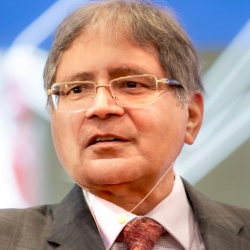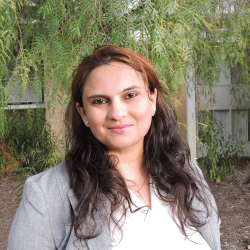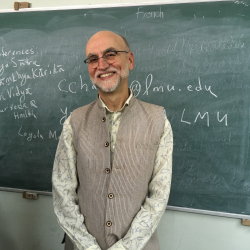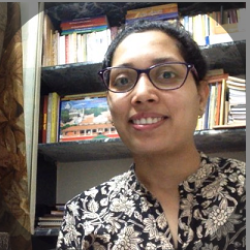
Agenda
Apr 20
2024
8AM-3:40PM PDT
2024
8AM-3:40PM PDT
8:20 am - 8:40 am
Ethical Dimensions of Jain Yoga, Ahiṃsā, and the Jain Concept of Life
20 mins
In this paper I first discuss the uniqueness of Jain Yoga with emphases on the reality of the world, the concept of the soul (jīva), and the doctrine of karma, as well as the progressive stages (guṇasthāna) the Jain tradition articulates to move beyond the various effects of karma. Next, I focus on the importance of the Jain principle of ahiṃsā both to Jain yoga and philosophy, as well as to the doctrine of karma and the goal of liberation. I, then, explore the robust concept of life (jīva) that Jain philosophy provides. After explaining the interrelated nature of Jain yoga, ahiṃsā, and the Jain concept of life, I argue that the thoroughness of Jain emphases on non-violence (ahiṃsā) to all forms of life understood in both the planetary context and the context of liberation, is both internally consistent and remains the vanguard for expressions of non-violence in the field of ethics. Finally, I provide reflection on the coherence of Jain ethics with complementary contemporary ethical theories.
Read MoreRead Less8:40 am - 9:00 am
Jain Yoga on the Berlin Wall: Narendra Kumar Jain’s Seven Stages of Enlightenment
20 mins
This presentation considers Dr. Narendra Kumar Jain’s (1937-) mural, The Seven Stages of Enlightenment (SSE), a popular mural at the Berlin Wall’s Eastside Gallery. Jain’s mural features a meditating yogi with seven cakras, the name of Mahavira, and several other religious and spiritual symbols and figures. Analyzing the SSE’s creative bricolage requires an interdisciplinary method which draws from Yoga Studies and Jain Studies but also studies of Indian art history and political science. Using these fields of inquiry together will help us understand why and how these various influences have converged in Jain’s mural. Jain stresses the apophatic nature of his artistic work and his own universal Jain and yogic identity through his artistic production. Nevertheless, I engage Sonal Khullar’s notion of Indian artists’ “worldly affiliations” to demonstrate how myriad transnational forces, relationships, and opportunities within Jain’s “affiliative network” situate his mural in a very particular socio-historical location. By engaging with his affiliative network, I show how Jain produced a that work is clearly contextualizable, but perhaps, following his yogic training, also expressive of an experience of transcendence which he had imported from India to Berlin.
Read MoreRead Less9:00 am - 9:20 am
Karma Yoga in Jainism: Shrimad Rajchandra’s Integrating Renunciation and Action
20 mins
Recent studies (e.g., Chapple and Bohanec et al.) explore the Jain’s praxis of prayer, meditation, yoga, and ritual through various texts and traditions. Regarding yoga, most scholars focus on contemplative practices encompassing discipline and meditation. These writings present an image of the yoga and meditation practitioner as a world renouncer. For example, in one of his essays, John Cort elucidates the term yogi in South Asian traditions as someone “who has in some ways renounced the world, and thereby engages in conduct that runs counter to the norms of the householder.” Such assessment of South Asian yogis arises from the prevalent examples of various renunciate figures in Jainism and other Dharma traditions. However, the life of Shrimad Rajchandra (1867-1901) presents a unique model of a householder-renunciate. Shrimad conducted a lucrative business and lived a family life, navigating both pravṛtti (worldly-engagement) and nivṛtti (renunciation) simultaneously. In this paper, I will explore select biographical writings on Shrimad Rajchandra that draw attention to the binary strands of his contemplative predictions and his life as a householder. More importantly, while his biographies generally celebrate his detachment from worldly affairs because of the Jain doctrine of renunciation, Shrimad Rajchandra dexterously performed business and participated in family and spiritual life. I argue that Shrimad represents a modern example of a karma yogi—one who performs detached action—as defined in the Bhagavad-Gita. His Karma yoga inspired Mahatma Gandhi’s ascetic-activism, a synthesis of the spiritual aspirations and actions in service of the humanity. Using Gandhi as an exemplary figure, I will show how Shrimad Rajchandra can offer an example for contemporary lay followers who, although bound by worldly actions, seek a viable path to liberation.
Read MoreRead Less9:25 am - 9:45 am
Intersecting Paths: The Role of Language and Intertextuality in Second Millennium Jain Yoga Texts
20 mins
The thriving field of Jain Yoga Studies offers a unique perspective within the broader Yoga Studies landscape, particularly in exploring the textual and practical dimensions of Jain yoga. This presentation focuses on key Jain yoga texts of the second millennium, notably the Yogapradīpa, and their intertextual relations with Jain and non-Jain yoga texts, underscoring the Jain tradition's contribution to the pan-Indic rubric of yoga. A critical aspect of this research is the linguistic strategy employed in these texts. The Yogapradīpa, composed in Sanskrit but also accompanied by Old Gujarati commentaries, demonstrates Jainism's dual commitment to doctrinal fidelity and broader accessibility. This linguistic adaptability reflects Jainism's dialogic engagement with various philosophical and religious landscapes, particularly in the context of yoga practices such as meditation and contemplative disciplines. Moreover, this presentation will offer an examination of the Yogapradīpa in relation to other contemporaneous Jain and non-Jain yoga texts. By analyzing similarities and divergences in content and style, this research highlights the dynamic interplay between various yogic traditions and Jainism's unique contributions to the broader yogic landscape.
Read MoreRead Less9:45 am - 10:05 am
Ten Million Gold Coins and 500 Thieves: Sage Kapila Kevali’s Journey of Jain Samādhiyoga in the Uttarādhyayanasūtra
20 mins
For this presentation, I will read the eight chapter ascribed to Sage Kapila and titled “Kāpilīya” (also called “Kāpilīyamadhyayanam”/ pkt. Kāvilīyam) of the Uttarādhyayanasūtra, one of the earliest Jain canonical texts. By doing so, I will explore various ways in which the content and composition of this chapter probe into samādhiyoga, expounding upon the Jain principle of non-attachment, rebirth, state of enlightenment, and ideal ascetic life and conducts. Next, I examine this chapter and the commentarial works on it for how they offer different scopes in illuminating our understanding of Jain samādhiyoga, the presence of non-Jain/non-Jina “sage” as the author—identified as “svayaṃsaṃbuddha” (“self-enlightened”), and the aesthetics as can be seen from the narration and its composition. I see this presentation as offering a fresh investigation into how Jain literature of the earlier period presented the founding stones of Jain yoga.
Read MoreRead Less10:10 am - 10:30 am
Kāyotsarga: An Understanding of the Ritualistic and Non-ritualistic Versions
20 mins
This paper aims to illuminate the phenomenon of kāyotsarga, a Jain meditative practice that originates in the early canonical period. Its development can be traced throughout the canonical, post-canonical and medieval periods, particularly within the Āvaśyaka literature. In the modern period, kāyotsarga is re-interpreted and popularized as an integral part of “Prekṣā Dhyāna” by the tenth head of the Jain Terāpanth sect, Ācārya Mahāprajña (1920-2010). Prekṣā meditation is legitimized via linkages that trace it back to the spiritual practices of Mahāvīra. It is argued that modern kāyotsarga has also much influenced by interactions and influences from Hindu yogic traditions, and by Western science and relaxation therapies. This paper demonstrates how the aims and status of kāyotsarga shifts over time, from a purely monastic meditative practice with spiritually orientated aims to one that becomes accessible to laypersons with more worldly-focused goals. Furthermore, this paper is also an attempt to understand the development of the stages non-ritualistic kāyotsarga. It includes five stages: (1) relaxation (śithilīkaraṇa); (2) experience of vital force (prāṇa); (3) experience of separation of the gross body (sthūla-śarīra) and fiery body (taijasa-śarīra); (4) experience of vibration (spandana) of the karmic body (kārmaṇ-śarīra) and (5) experience of the separation of the body and the self (bheda-vijñāna). At the highest stage of kāyotsarga, Mahāprajña explains an understanding and experience of Jaina metaphysical dualism is a journey of the self-experience. Finally, I will conclude how this religious practice is presented in a secularized approach.
Read MoreRead Less10:30 am - 10:50 am
Symmetry and Karmic Release
20 mins
This presentation will build on earlier studies of the Yogabindu, Yogadṛṣṭisamuccaya, Jñānārṇava, Yogaśāstra, 32/32, and the applied contemporary forms of Yoga originated by Acharyas Mahapragya and Shiv Muni. According to the Tattvārtha Sūtra, the human body carries 42 types of karma (8.12). The eighth division will be considered here, relating to the configuration of the body as symmetrical, the most auspicious form, and five variant forms. Commentaries will be explored that discuss this assessment of corporeality and its relationship to particular karmic constitution and construal. Several questions will be posed: does asymmetry post a barrier to spiritual practice? According to research by Kristi Wiley, “being born with a severely deformed body [happens]… as the result of extremely evil actions in some previous life” (Wiley, 2000. 168). On the other hand, contemporary teachers say such physical form does not prevent one from taking vows and thereby releasing karmas. Another question will ask to what degree do the practices of āsana and prāṇāyāma facilitate symmetry? Jainism can be seen as not distinguishing between the metaphysical from the physical: all physicality depends upon the metaphysical history of each individual’s karma. This presentation will explore Jain texts and oral traditions in regard to the human body, and examine the role of movement and breath in regulating the body, preparing it for meditation.
Read MoreRead Less12:10 pm - 12:30 pm
Can AI Meditate: An Exploration into the Theory and Practice of Jainism’s Dharma Dhyāna
20 mins
Artificial Intelligence (AI) is now capable of visualizing data and creating new content using preexisting data which is quite similar to the feeding of imaginations to a human mind. It assists modern yogīs by creating unique experiences through guided meditation. Although AI can tell how to perform meditation and gauge individual results for better performance, the absence of consciousness limits its capabilities. However, as meditation or dhyāna is thought to be essential for spiritual progress, could there be a likelihood for AI to meditate? In the Jain spiritual realm, although the pure soul is the object of the transcendental pious meditation (niścaya dharma-dhyāna), the mundane pious meditation (vyavahāra dharma-dhyāna) relies on external objects including visualizing mantras and colorful objects on different body parts. This implies that if meditation is simply the engagement of sensory organs, then AI may also perform it. Given this hypothesis and drawing from the 11th-century Digambara Jain text Jñānārṇava, this paper intends to explore the theory and practice of mundane pious meditation. While scholars have begun to dabble with the intersection of AI and philosophy, this study analyzes the relationship between mundane and transcendental pious meditation that calls into question the possibilities of a meditating AI.
Read MoreRead Less12:30 pm - 12:50 pm
“Sandhi” (Juncture): The Jain Canonical Contemplative Practice and Transcendental Realization
20 mins
Ācārāṅga Sūtra, the first book of Jain canonical literature, throws some light on the notion of sandhi. The terms juncture, aperture, hole, wheel, lotus, plexus etc. are used synonymously to translate this term. The light of transcendental knowledge spreads out of this karmic aperture(sandhi). The purity of the karmic particles in the soul-points (ātma-pradeśa), the conglomeration of conscious space points that make up the soul, is found in the physical body to act in a particular direction. This is the reason why the clairvoyance (avadhī jñāna) due to karmic purity is described as situated in the body. In the case of the purity of all the soul-points the clairvoyance that functions in a particular direction is described as situated in the body. In the connection with clairvoyance, the word karaṇa (efficient cause) is explained as an organ of the body or a part of the body through which the clairvoyant knows the objects. Any part of the body which becomes karaṇa or the psychic center which gets awakened, becomes the region through which the rays of super-sensory knowledge emerge out. It is a mode of understanding or knowing characterized as direct and immediate and occurring without conscious thought or judgement. The present paper is an endeavor to bring to light the ancient contemplative practice that opens the transcendental world and are termed as “intuition” or “insight” in modern jargon.
Read MoreRead Less12:50 pm - 1:10 pm
Rāga in the Six Āvaśyakas: Desire as Both A Cognitive Obstruction & Contemplative Catalyst to Liberation
20 mins
This paper explores the paradoxical rejection and embrace of different typologies of desire (rāga) in Jain traditions, which identify some forms of rāga as cognitive obstructions that are incompatible with liberation while identifying others as contemplative or yogic auxiliaries to liberation. Such juxtaposition is evident in the six āvaśyakas, the obligations of Jain ascetics, which variously emphasize the contemplative renunciation and cultivations of different desires. For instance sāmāyika, mental equanimity cultivated through the renunciation of all attachments, aims to help practitioners transcend the worldly desires that obstruct liberation. By contrast the Caturviṃśatistava, a hymn to the twenty-four Jinas, is depicted in the Śvetāmbara Āvaśyaka Sūtra as being both a hymn of glorification and supplication that explicitly requests liberation, wisdom, samādhi, and perfection from the Jinas. Since the Jinas are entirely desireless or dispassionate (vītarāga) and remain unresponsive to practitioners, such desires cannot ever be fulfilled by them. This paper argues that such hymns therefore demonstrate the importance of practitioners cultivating certain desires, which together constitute a typology of contemplative practice. This paper closes with consideration of the potential parallel with the Advaita Vedāntin depiction of mumukṣā, the desire for liberation, which is depicted as a necessary precursor to liberation.
Read MoreRead Less1:15 pm - 1:35 pm
Orienting Hemacandra’s Yoga-śāstra in Relationship to Patañjali’s Yoga-sūtra and Haribhadra’s Yoga-dṛṣṭi-samuccaya
20 mins
Hemacandra’s Yoga-śāstra (YŚ) seems to have benefited from Haribhadra’s interface between traditional Jain doctrine (such as is found in the Tattvārtha-sūtra) and the pan-dharmic yoga tradition. We can see this with the similarities between Haribhadra’s eight yoga-dṛṣṭis in the Yoga-dṛṣṭi-samuccaya (YDS), and Patañjali’s aṣṭāṅgas in the Yoga-sūtra (YS), for example. Hemacandra’s YŚ seems to be continuing that work by interfacing Jain doctrine with Patañjali’s system. For example, while Haribhadra’s eight-fold yoga-dṛṣṭis are less explicitly related to Patañjali’s aṣṭāṅgas, the alignment between the Yoga-śāstra and Patañjali’s aṣṭāṅga-yoga system is apparent and explicit. Moreover, as a broad conceptual framing, all three texts involve an explicit teleological movement from preliminary “active engagement” (pravṛtti) to superlative “withdrawn disengagement” (nivṛtti) and subordinate valuation of pravṛtti practices compared to nivṛtti. This is achieved with shared frameworks such as the YS bhāvanā pravṛtti meditation (with objects) that elevates the final nivṛtti state of upekṣa that are conceptually similar to the nirodha of the Yoga-sūtra, and is also a framework employed in the YŚ. These Jain thinkers aligned with Patañjali’s nivṛtti-emphasis by using similar concepts such as the teleology of the YDS that leads to “renouncing dharma” (dharma-saṃnyāsa) and “ceasing yoga practice” (viniyoga) and moving “beyond any conduct” (nirācārapada) and the superlative nivṛtti states in the YŚ such as “withdrawn indifference” (audāsīnya) the problematization of effort, “no-mind” (unmanībhāva) etc. Of course, there are many dissimilarities between these texts and yoga systems, but a comparative reading of these texts evinces a critical strategy that Jain thinkers followed of dialoging with, and borrowing from, the (premodern) pan-yogic movement as a means towards peaceful interfaith dialogue and asserting orthodox Jain teachings by employing and interfacing with the popular yoga idioms.
Read MoreRead Less1:35 pm - 1:55 pm
The Four Bhāvanas in Jain Yoga Texts
20 mins
The cultivation (bhāvanā) of benevolence (maitrī), sympathetic joy (pramoda), compassion (karuṇa), and equanimity (madhyastha) has an important place in Jain Yoga. According to the Tattvārtha Sūtra (TS), benevolence is to be practiced towards all living beings; sympathetic joy towards the virtuous; compassion towards the afflicted; and equanimity towards the unvirtuous. In Jain ethical training, one virtue or another is to be practiced depending on the particular situation at hand, a process requiring careful discernment and engagement with one’s surrounding social environment. An almost identical ethical practice often referred to as the brahma-vihāra has been well-researched in the field of Buddhist Studies. However, scholarship in the Jain context is very limited, despite their relevance in Jain ethics, philosophy, and soteriology. This presentation will explore how different Jain authors have defined the four bhāvanās in Jain Yoga texts, and how this occurred in engagement with the Buddhist and Brahmanical intellectual environment. This will include different interpretations of the bhāvanās from some of the great philosophers of Jainism, such as Umāsvāti and Haribhadrasūri, followed by more significant consideration of their culmination in the work of Yaśovijaya who elaborates upon the bhāvanās extensively. While the term bhāvanā has taken on a number of meanings in Jain Yoga texts, in this presentation, I pay particular attention to the four bhāvanās of benevolence, sympathetic joy, compassion, and equanimity.
Read MoreRead Less1:55 pm - 2:15 pm
Jain Yoga and Integral Vedānta: A Conversation between Yaśovijaya and Swami Vivekananda
20 mins
This presentation will bring elements of Jain Yoga, specifically as articulated by Yaśovijaya in such works as his Jñānasāra, into dialogue with the Integral Vedānta of Swami Vivekananda (and in particular with the philosophy and practices outlined in his Rāja Yoga). Points of both overlap and divergence between these two major thinkers will be explored, with the aim of discerning ways in which each system of thought and practice can inform the other. This will be conceived as an example of Hindu-Jain comparative theology: that is, of what Francis X. Clooney has characterized in his work as “deep learning across religious borders.” Tentatively, the thesis will be that both of these systems emphasize the differentiation of self from the material body, while simultaneously utilizing the material body (through such practices as breath control) to achieve this differentiation. Furthermore, a link between these two systems can be discerned in the form of the Sāṃkhya and Yoga darśanas, which have, on the one hand, numerous similarities with the Jain tradition, and on the other, are a major source on which Swami Vivekananda draws in his articulation of Rāja Yoga. Indeed, much of his book, Rāja Yoga, is presented as a commentary on the Yoga Sūtras of Patañjali.
Read MoreRead Less2:20 pm - 2:40 pm
Jaina Yoga, Jain Ayoga? What Yoga Might Exclude
20 mins
The academic study of religion has slowly outgrown its earlier premise of locating the essence of religious traditions in doctrines, scriptures, and philosophies. The turn to the study of lived religion enabled us to come to grasp the fundamentally embodied and multi-sensorial nature of religious practices. With that, aspects of, for example, Jainism formerly deemed marginal, exclusively lay, or later developments (‘medieval accretions’), like devotional, ritual, and story-telling practices, can now be appreciated more fully as foundational to the formation of Jaina selves. In recent decades, various Jaina traditions have come to develop new contemplative practices. While far less Jains engage in these forms of Jaina yoga than in traditional praxis, they are widely propagated, supported by innovative infrastructure and published meditation manuals. Meanwhile, and similarly in line with the boom of transnational yoga, the new academic discipline of Yoga Studies emerged. Its focus on embodiment and practice-over-theory is at first sight the antithesis to the logocentrism and ‘belief in belief’ of earlier Orientalist scholarship. Still, an unreflected focus on Jaina yoga, I argue, risks pronouncing a value judgement of different religious practices, enforcing reigning discursive formations. Knowingly or unknowingly, explicitly or implicitly, practices labelled ‘yogic’ could be presented or read as superior to other aspects of Jaina praxis like ritual, devotion, and narrative, which would once again remain denounced as ‘ayogya’, ineffective, inferior.
Read MoreRead Less Parveen Jain
Parveen Jain Christopher Jain Miller
Christopher Jain Miller Cogen Bohanec
Cogen Bohanec Panelist: Andrew Bridges
Panelist: Andrew Bridges Panelist: Veena R. Howard
Panelist: Veena R. Howard Panelist: Corinna May Lhoir
Panelist: Corinna May Lhoir Panelist: Venu Mehta
Panelist: Venu Mehta Panelist: Samani Pratibha Pragya
Panelist: Samani Pratibha Pragya Panelist: Christopher Chapple
Panelist: Christopher Chapple Panelist: Tine Vekemans
Panelist: Tine Vekemans Panelist: Pragya Jain
Panelist: Pragya Jain Panelist: Samani Rohini Pragya
Panelist: Samani Rohini Pragya Panelist: Eileen Goddard
Panelist: Eileen Goddard Panelist: Alba Rodríguez Juan
Panelist: Alba Rodríguez Juan Panelist: Jeffery D. Long
Panelist: Jeffery D. Long Panelist: Tillo Detige
Panelist: Tillo Detige Panelist: Steven M. Vose
Panelist: Steven M. Vose